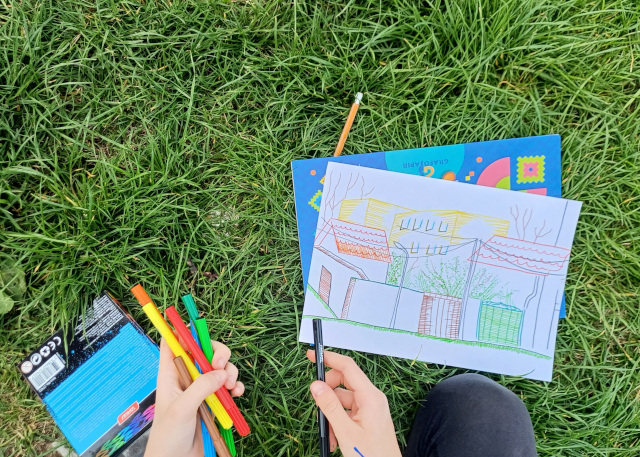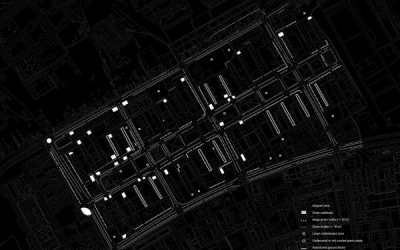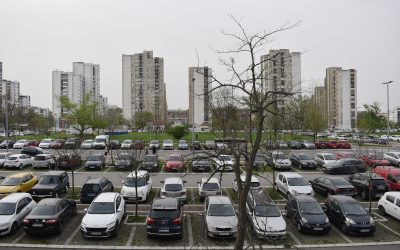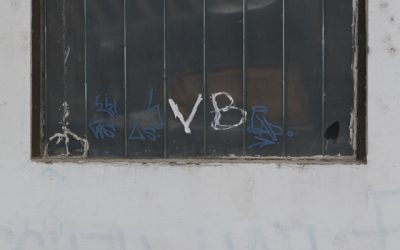Walking and Drawing Bežanija Village. Creating Alternative Images for the Periphery of the City.
Maria Mendez
Bežanija Village is the oldest settlement still standing in New Belgrade. Its characteristic pitched-roof housing typology and urban structure edged by vineyards is today found cornered between the plateau and the high concrete residential towers of the brutalist era. Bežanija Village is unique; it holds landscape, heritage, and social value that deserves to be preserved amidst the rapid urban development: so much so that there is already a local citizen association in charge of keeping alive the memory of Old Bežanija.
When BINA proposed i should work in this area of the city, I was surprised to hear that it was under threat: when visiting, my perception was not only that it had a unique charm and significance and a peaceful atmosphere, like many historical places; it also generated an interesting contrast and remarkable variety in the urban landscape coexisting with the brutalist towers, very different in scale and in proportions. In the age when all cities are becoming more and more alike, I am convinced of the value and importance of working for this neighborhood’s preservation amidst the rapid urban development.
In my practice, I seek to explore peripheral or contested spaces, using subjective and experiential practices like drawing and walking. My research strives for a sensitive and immersive approach to studying and engaging with these suburban areas, challenging conventional perspectives. The focus is on paying attention to the places as they are and giving voice to their unique identities and stories, questioning the predefined narratives that have been created elsewhere.
By drawing and walking, the project seeks to make participants establish an intimate connection with the environment, capturing their subjective experiences through artistic expression. Walking and being present with our bodies allows us to embrace uncertainties and serendipities in navigating these peripheral spaces, while doing it collectively enables us to share our insights and deepen our way of looking through the perspectives of others. This immersive nature of the situated practice also promotes a deeper understanding of how diverse behaviors and needs – not only human – shape these territories. By paying attention, we can uncover the traces of the past, realities of the present and potentialities of the future within these often-overlooked areas.
In this way, drawing and walking also hold transformative power in urban discourse, envisioning possibilities beyond conventional planning, fostering a reflective, collective and imaginative approach to urban decision making. This empowers us to conceive new interactions and possibilities for the built environment.
It is crucial to generate spaces where we can discuss our perceptions and experiences around a territory in order to create new narratives, and the ways to represent it that are ours. The project thus seeks to bring about a collective, openly complex and qualitative narrative that values the territory’s uniqueness. By fostering a deeper connection with the space, it contributes to our ability to be aware of the necessity and advocate for more responsive and empathetic urban practices that respect the realities and needs of peripheral territories and communities.
An important remark is also that the project has been impacted by the fact that I am a foreigner here in Belgrade. First of all, I do not understand Serbian words. But I do understand Serbian drawings: drawing therefore becomes a language that goes beyond borders, emerging as the main language of the project and potentially questioning the dynamics that appear when oral languages are predominant.
Secondly, this fact also allows us to explore the ways in which narratives and stories of places are represented and conveyed to people who – like me – do not know them, whether in the form of tourist souvenirs or as guided tours. The experience of drawing together means also the possibility for the participants to show me their city, for me to see it through their eyes, and for them in turn to see it again through mine, as if they have never seen it before, to appreciate all its possibilities from a fresh perspective.
Lastly, all this leads us to reflect on what images and iconography are used to showcase our territories and with what objectives (solely touristic or economic? In what way does it affect the local level?), in what contexts (only in the city center? only for tourists?), and by whom they are chosen and produced. How can we take ownership of the images that are shared of the places we inhabit? Can the practice of drawing be useful in making these images closer to our daily experience of the territory, i.e. more our own?
Building upon these questions, the project outcome will work with the language of the tourist objects (souvenir): postcards, t-shirts, tote-bags… Based on the drawings made in the collective encounters, an alternative version of these elements (our own merchandising!) will be made for Bežanija Village, in order to restore its value in a symbolic way for its inhabitants and the rest of the city.
The implementation of the project was supported by the citizens’ association “Stara Bežanija”. Special thanks to Volga Ilić, the president and Božidar Jojić.
The following participated in the project:
– 7th grade students of “Jovan Sterija Popović” elementary school: Dunja Dinić, Dunja Karišić, Milica Vučetić, Mila Maslać, Ana Blagojević, Nina Ožanić, Jelena Radošević, Čarna Josifović and Tea Tošev
– Students: Boško Zdravković, Ahmed Kamberović, Petar Karanović, Maša Bubanja, Jana Valjarević, Ana Popović, Lenka Prodanović, Dunja Đurić, Srna Perišić, Teodora Živković, Milica Mitić, Lara Marras and Lana Jeremic – LINA Fellows: Sara Ramezani and Giulio Galasso








